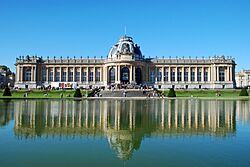Tervuren facts for kids
Quick facts for kids
Tervuren
Tervueren (French)
|
|||
|---|---|---|---|

The Royal Museum for Central Africa (RMCA), seen from the park behind the museum
|
|||
|
|||
| Country | Belgium | ||
| Community | Flemish Community | ||
| Region | Flemish Region | ||
| Province | Flemish Brabant | ||
| Arrondissement | Leuven | ||
| Area | |||
| • Total | 32.92 km2 (12.71 sq mi) | ||
| Population
(2018-01-01)Lua error in Module:Wd at line 1575: attempt to index field 'wikibase' (a nil value).
|
|||
| • Total | Lua error in Module:Wd at line 1,575: attempt to index field 'wikibase' (a nil value). | ||
| Postal codes |
3080
|
||
| Area codes | 02 | ||
| Website | www.tervuren.be | ||
Tervuren is a town in Belgium. It is located in the Flemish Brabant province. This area is part of the Flemish region of Belgium. The town includes several smaller villages. These are Duisburg, Vossem, and Moorsel.
In 2006, Tervuren had over 20,000 people living there. The town covers about 33 square kilometers. This means there are around 627 people per square kilometer.
The main language spoken in Tervuren is Dutch. This is true for all of Flanders. Many people from other countries also live here. These include people from the European Union, the UK, the USA, and Canada.
Many international workers live in Tervuren. They often work in Brussels for groups like the EU or NATO. Some work for large international companies. The British School of Brussels is also in Tervuren. It has been there since 1970. Tervuren also has an English-speaking church. It is called St. Paul's Church.
Tervuren is known as one of the wealthiest towns in Belgium. It is very close to the Brussels-Capital Region. A large road, Tervurenlaan, connects Tervuren to Brussels. King Leopold II built this road. It was for the 1897 World's Fair in Brussels. A tram line also runs along this road. This tram is both for daily travel and for tourists.
Contents
History of Tervuren
For a long time, people thought Tervuren was a place called "Fura." This is where Saint Hubert supposedly died in 727 AD. But there is no real proof of this. Experts now think "Fura" was in a different place.
A document from 1213 AD shows that Henry I, Duke of Brabant was in Tervuren. He might have had a wooden fort there. This fort later became Tervuren castle. It was a home for the dukes of Brabant. This was during the 14th and 15th centuries.
The castle was torn down in 1782. This was ordered by Joseph II. He also removed another building called Château Charles. This was a summer home for Prince Charles Alexander of Lorraine.
After 1815, the park of Tervuren was given to William. He was a prince and built the Pavilion of Tervuren. This building sadly burned down in 1879.
The Tram 44 goes from Brussels to Tervuren. It also stops at the Royal Museum for Central Africa. King Leopold II wanted this tram. He wanted to bring visitors to his 1897 exhibition. This exhibition showed things from the Congo Free State.
Culture and Museums
AfricaMuseum: A Place to Learn
The Royal Museum for Central Africa is now called AfricaMuseum. It is a museum about different cultures and nature. It mainly focuses on the Democratic Republic of the Congo. This country used to be a Belgian colony.
The museum also studies the whole Congo Basin. This includes parts of Central, East, and West Africa. It was first a museum about colonies. But since 1960, it focuses more on people and their cultures. Some researchers here work closely with the Royal Belgian Institute of Natural Sciences.
The museum is surrounded by beautiful gardens. It has the biggest giant redwood tree in Flanders. There is also a large park with lakes. The St Hubert Chapel is at one end of the park.
Tervuren Library
The Tervuren Library is called Gemeentelijke Openbare Bibliotheek Tervuren. It is located at Markt 7. The library has many books and DVDs. It has about 43,300 printed items. It also has 886 DVDs for people to borrow.
Schools in Tervuren
Tervuren has several schools for different ages.
- The Gemeentelijke Basisschool Tervuren has a kindergarten and a primary school.
- The Heilig Hartcollege (HHC) Tervuren also has a primary school. It also has a grammar school for older students.
- The Koninklijke Atheneum Tervuren (KAT) is both a primary and a grammar school.
- The GITO is a secondary technical school. It teaches practical skills.
- The British School of Brussels is an international school. It has been in Tervuren since 1970.
- The Kristoffel Steiner School uses the Steiner method of teaching. It started for young children. Now it is adding primary school education. This method is supported by the government. It follows the Steiner curriculum in Flanders. It is Dutch-speaking but welcomes children from many countries.
Twin Towns
Tervuren has special connections with other towns. These are called "twin towns."
- Dachau in Germany
- Oosterbeek in the Netherlands
- Kloster Lehnin in Germany
Notable People from Tervuren
Many interesting people have lived in Tervuren.
- Luc Coene: He was the governor of the National Bank of Belgium.
- Ward Lernout: A well-known painter.
- Miel Puttemans: A famous athlete.
- Prince Laurent of Belgium: A member of the Belgian royal family.
- Henry Van de Velde: A painter, architect, and designer.
- Christian Dotremont: A painter and a founder of the COBRA art movement.
- Frank Vandenbroucke: A politician.
Images for kids
See also
 In Spanish: Tervuren para niños
In Spanish: Tervuren para niños







